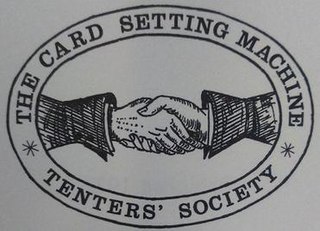Related Research Articles

The Bakers, Food and Allied Workers' Union (BFAWU) is a trade union in the United Kingdom. Founded in 1847 in Manchester, it represents workers in the food industry.
The Workers' Union was a general union based in the United Kingdom, but with some branches in other countries. During the 1910s, it was the largest general union in the UK, but it entered a rapid decline in the 1920s, and eventually became part of the Transport and General Workers' Union (TGWU).
The Miners' Federation of Great Britain (MFGB) was established after a meeting of local mining trade unions in Newport, Wales in 1888. The federation was formed to represent and co-ordinate the affairs of local and regional miners' unions in England, Scotland and Wales whose associations remained largely autonomous. At its peak, the federation represented nearly one million workers. It was reorganised into the National Union of Mineworkers in 1945.
The National Union of General Workers (NUGW) was an early general union in the United Kingdom, the most important general union of its era.

The Confederation of Shipbuilding and Engineering Unions (CSEU), often known as the Confed is a trade union confederation in the United Kingdom.
The National Union of Blastfurnacemen, Ore Miners, Coke Workers and Kindred Trades (NUB) was a trade union in England and Wales which existed between 1888 and 1985. It represented process workers in the British iron and steel industry.
The United Textile Factory Workers' Association (UTFWA) was a trade union federation in Great Britain. It was active from 1889 until 1975.
The Amalgamated Association of Beamers, Twisters and Drawers (AABTD) was a British trade union which existed between 1866 and 2002. It represented skilled workers in the cotton industry who were responsible for preparing warp yarns prior to weaving.
The Amalgamated Society of Textile Workers and Kindred Trades (ASTWKT) was a trade union representing textile workers, principally silk manufacturing, in the United Kingdom.
The General Union of Loom Overlookers (GULO) was a trade union representing junior supervisors in textile manufacturing in the United Kingdom. While most members were based in Lancashire, it also had members in Yorkshire, East Anglia and Essex.

The Card Setting Machine Tenters' Society (CSMTS) was a trade union representing workers responsible for setting up textile carding machines in the United Kingdom.
The North East Lancashire Amalgamated Weavers' Association was a trade union federation of local weavers' unions in part of Lancashire in England, in the 19th century.
The National Union of Textile Workers was a trade union representing workers in the textile industry in England, principally in Yorkshire.
The Amalgamated Union of Upholsterers (AUU) was a trade union representing upholstery workers in the United Kingdom.
The Burnley and District Weavers', Winders' and Beamers' Association was a trade union representing workers in the cotton industry in the Burnley area of Lancashire, in England. As cotton manufacturing dominated the town's economy, the trade union played an important role in the town, and several union officials became prominent national figures.
The Blackburn and District Weavers' Winders' and Warpers' Association was a trade union representing cotton industry workers in Blackburn, Lancashire, in England. One of the earliest weavers' unions to endure, it formed a model that many others copied, and was at the centre of early attempts to form a regional federation of cotton trade unions.
The Nelson Weavers' Association (NWA) was a trade union representing cotton weavers in the area of Nelson, Lancashire. As the main industry in the town, the union has been influential in its history, and some of its leaders became significant national figures.
The Preston and District Weavers', Winders' and Warpers' Association was a trade union representing cotton weavers in the Preston, Lancashire, in England.
The Padiham and District Weavers', Winders' and Warpers' Association was a trade union representing cotton weavers in the Padiham area of Lancashire, in England.
The Manchester and Salford Weavers' Association was a trade union representing weavers in part of Lancashire, in England.
References
- 1 2 3 Marsh, Arthur; Ryan, Victoria (1984). Historical Directory of Trade Unions. 2. Aldershot: Gower. p. 60. ISBN 0566021617.
- ↑ "The General Federation of Trade Unions". Annual Report of the Trades Union Congress: 21. 1899.
- ↑ Labour Party, Report of the Forty-Fifth Annual Conference of the Labour Party, pp.73-78
- ↑ Crick, Martin (1994). History of the Social-Democratic Federation. Keele University Press. p. 307. ISBN 1853310913.
- 1 2 "Obituary: John Crompton". Annual Report of the Trades Union Congress: 319. 1959.
- ↑ McIlroy, John (1995). Trade Unions in Britain Today. Manchester: Manchester University Press. p. 12. ISBN 0719039835.
- ↑ Marsh, Arthur; Ryan, Victoria (2016). Historical Directory of Trade Unions. 4. Routledge. ISBN 1351964631.